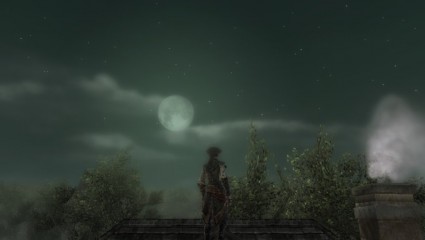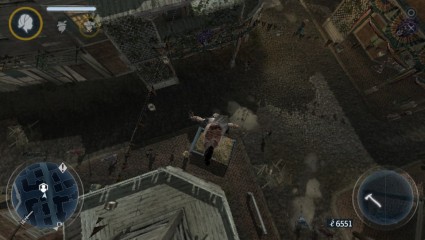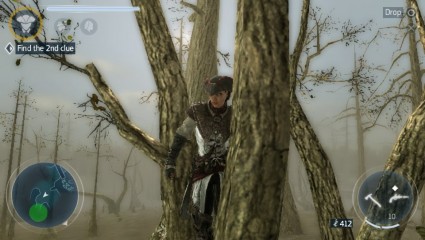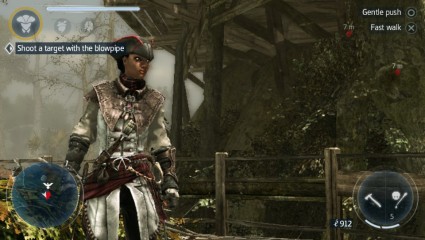Reviews
Assassin’s Creed III: Liberation
November 13, 2012, Author: Andy Corrigan
Although I’ve always enjoyed what I’ve played of the Assassin’s Creed series (especially Brotherhood), I probably wouldn’t call myself a huge fan. My interest has certainly waned in recent years following Revelations and, until recently, I had little-to-zero interest in Assassin’s Creed III.
Still, the idea of Assassin’s Creed III: Liberation on Vita has really fascinated me since it was announced earlier this year. Could it really nail almost everything the series does well on Vita?
Who’s that girl?
Liberation really had the opportunity to tell Assassin’s Creed’s most interesting story thus far, especially given the main character’s background. Unfortunately, it just falls short of the mark, thanks to poor pacing and lack of overall narrative direction, although I can categorically state that none of that is as a result of the protagonist.
You play the series’ first female assassin, Aveline de Grandpré; a softly spoken yet strong-willed French-African born into a wealthy family in 18th Century New Orleans. Publically, she’s a lady of leisure in the upper echelons of society, but spurred on by the death of her birth-mother and her desire to help her own people, she leads an exciting double life. She’s an aristocrat by day, deadly assassin by night; she’s essentially an 18th Century Bruce Wayne.
With her mixed heritage and upbringing, you could have been looking at our most internally conflicted assassin yet, though Ubisoft have opted to play it safe. The plot meanders around potentially absorbing flashpoints, before devolving into the typical tale of Brotherhood vs. Templar, only not ever as engaging as the stories we’ve already seen. When it does offer up what you were hoping for, it feels too late and rushed, and leaves you lacking any investment in the final pay-off.
The game also ditches Desmond (a blessing or a curse, depending on your position as to his involvement), and presents the game as an Abstergo retelling of history. This means the lines are blurred as to whether what you’re playing is at all true or not. At times in-game you’ll be presented with the option to find and kill a hacker named Citizen E, who is trying to restore the correct telling of history in Abstergo’s product. By doing so, you’ll be presented with the ‘truth’. It makes it hard to tell whether you should be invested in the plot or not…

Aveline looks out over her city, about to run her 'errands' for the night...
Rough edges…
Thankfully, despite its shortcomings in story, this is an Assassin’s Creed title as you know and love. Outside of a few Vita-specific features, the classic control scheme remains intact, and almost everything that you’ve done before, bar horse-riding, is available for you to do exactly as it has been in the home console games. You’ll be climbing, free-running, taking on the game’s many side-missions, killing enemies and looting corpses. You’ll also be playing around with some new inventions courtesy of Aveline’s confidant, Gerald, and her Brotherhood mentor, Agate. The game has a few mechanics of its own, though.
The Persona system is the most prominent of these. Aveline can change her appearance as and when she likes (unless the mission dictates a specific persona) between Lady, Slave and Assassin, and each has its own benefits and weaknesses.
The classic Assassin persona, for example, allows you to pretty much do everything you’d expect; however, you’ll nearly always have a high notoriety level. The Slave persona allows you to keep all of your assassin’s skill-set, only offering you a better chance of remaining undetected, as you can pick up a crate and waltz into important areas, or join in the work with a bunch of slaves to avoid guards. The Lady persona takes away most of Aveline’s skill-set (aside from her blades), preventing her from running across rooftops, but she can charm or bribe her way into areas. She always runs the risk of being mugged in the less charming parts of town, though…
Each persona has its own notoriety level, so that if you’re fleeing the scene of a crime, you could run into one of the changing stations (you buy these buildings throughout, as well as the usual shops), change to a notoriety-free persona and walk away unnoticed. Each persona has its own way to clear its notoriety level too. For example, as the slave you need to tear down “Wanted” posters, while as the lady, you need to silence known witnesses.
While it’s a flexible system and allows you to tackle some of the missions in different and interesting ways, most of the time you’ll be forced into a particular persona based on where you’re heading. The early portion especially can become a bit grating before it opens up, as it regularly forces you into the Lady Persona, thus restricting everything that’s fun about Assassin’s Creed. As part of a tool kit the Lady Persona is a nice option to have, but when forced to use it, it feels as if the game is purposely holding you back rather than encouraging you to be imaginative with it. As with all the Assassin’s Creed games, though, it does open up eventually, and you’re allowed much more freedom part way in.

Give that girl gold!
While it matches its big brothers for most part, there are some rough edges. Combat can feel ropier here and there. At times, hitting the dodge/counter button occasionally felt like a lottery, no matter if I’d matched Aveline’s blade with one appropriate to the enemy’s. Sometimes it just doesn’t feel like the skillful dance of blocks and counters as seen in other Creed games.
Another annoyance came in how the game would frequently change selected weapons following cut-scenes or loading screens. I wouldn’t mind if it was always in context, but often it seemed completely arbitrary. You could be in the hunt, moving through the crowd, trying to trigger the subtle kill, but then realise that the game has since unhelpfully and silently switched you from the hidden blades to a tomahawk, which is far from a discreet weapon.
Aveline has some interesting tools to help take her foes down, though. Eventually you’ll acquire a whip, not only permitting you to pull enemies towards you for a telling blow, but also allowing you to swing across large gaps too big for regular jumps. You’ll also gain access to a blow-pipe, enabling you to use a couple of the poisons seen in previous games, as well as the ever-helpful smoke grenade.
In terms of showcasing the Vita’s unique features, it’s a bit of a mixed bag. Things like tearing open a letter by sliding your thumb and forefinger across both the touchscreen and the back touchpad are fine, as is pick-pocketing by sliding down on the backpad. Using the touch functionality to work the in-game map and your weapon selection is simple and natural.
On the flip-side, with some of the letters you’ll come across, you’ll have to find hidden messages by holding the Vita’s back camera to a bright light to enable subsequent controls. This system is fundamentally broken. After constantly failing to pick up the light coming from a nearby window, several times I tried holding the console directly in front of light bulbs, and even towards the sun, and it still took a couple of attempts at awkwardly waving my console around before it worked. I often play my Vita in bed at night, so I’d be stuffed if I wanted to make progress in the game without waking my sleeping wife.
Still, everything that made the Assassin’s Creed series worth playing is still in here. There’s a tremendous thrill when it all falls into place, as you’re flawlessly running and jumping from rooftop to rooftop, stalking your prey from above and deciding on the fly whether you want to be brutal or discreet. When it ebbs and flows just right and you’re at one with the controls, it’s almost an untouchable experience.

Tree hugger!
Blending in…
As a whole, Assassin’s Creed III: Liberation looks absolutely stunning considering everything it’s doing at any one time. Occasionally it’s inconsistent, with edges looking a little rougher in particular sections, but even then there is an amazing amount of detail on display for a portable game. The streets are always busy and moving with great atmosphere, packed with NPCs, all operating with different animations. Aveline’s own animation completely matches those of her fellow Brothers in previous games, on consoles with more oomph.
There is some variety too, with a nice mix between familiar Assassin’s Creed locales of developing cities, to the new environments of the Bayou, Connor’s Frontier, and the jungle area used only in a handful of chapters. The draw distance in each of these areas is impressive, and never seems to pop-in.
Unfortunately, there are some frame-rate stutters here and there, and you will find the occasional graphical glitch. I’ve had NPCs suddenly spawn once or twice while I’ve been darting around corners, while others have moved about erratically before disappearing though walls. I also had some enemies not complete their death animations, staying hauntingly frozen until they disappear. These issues do come few and far between at least, and never really ruined the game’s flow for me.
Hello Monsieur!
There is an unholy amount of speech packed into Liberation, as every single bit of dialogue is spoken, also matching the other Assassin’s Creed games in direction and in quality. The downside to the amount of spoken word does leave some of the sound-bites sounding a little compressed, but it’s a small price to pay as the game sounds alive no matter where you are.
Liberation also features one awesome soundtrack, although probably a little too typical of the franchise. Its usage is pitch-perfect, though, adjusting its tempo and urgency at all the appropriate moments, really helping to add to the drama unfolding. When you make your strike on a victim, and the old-fashioned fuzz are alerted, the music that kicks in makes you feel like you’re in for a fight.
Yo, I heard you like Facebook “games”…
Unfortunately, I found the multiplayer aspect of Liberation to be a bit of a pointless addition, as it’s not really a multiplayer component at all, more a Facebook-style social game. To be honest, I had even toyed with the idea of not writing about it, such is the little effect it has on the product.
Basically, you won’t be doing any of the cool things you do in the single-player, as it’s all menu-based. You’re simply running through some menus, picking a territory to fight, and letting the game dictate the results of those fights. If you win, points go towards your chosen side for that node; if you lose they go to the opposition, and thus both sides battle for control of the world. There’s no social element really; you’re simply playing the rest of the world anonymously.
It might appeal to some, but it’s not very involving.

The mission structure remains familiar.
Liberating?
On many levels, the game is a huge success, acting as further proof that no respectable developer should ever be thinking about scaling back their ambitions simply because they’re producing a ‘handheld’ game. Great things are clearly possible on Vita, and following recent efforts and the seeds of promise sown by Ubisoft here, we should be hopeful of a bright future for the system when ambitious projects like this are seeing the light of day.
It’s true that it’s not perfect, and the handful of flaws are all of Ubisoft’s making. There are some narrative and design choices that done differently would have made for a better, more rounded or exciting experience. Yet, when all is said and done, there is currently no other game on any portable format doing this much at any one time, with this much detail or this well. It simply has no peers or rivals on this or any format, yet.
Because of that, I think that most will find themselves able to forgive the game in spite of its handful of faults and missteps. I know I certainly have, because Assassin’s Creed III: Liberation is pretty much exactly what it had promised to be; a full Assassin’s Creed game on the Vita with few concessions made. If a portable Assassin’s Creed is all you want or are expecting, then you’re going to come away mostly happy with your purchase.
Platforms: PS Vita | Tagged Agato, Altair, assassin, Assassin’s Creed, Assassin’s Creed III, Assassin’s Creed III: Liberation, Aveline, Aveline de Grandpre, Brotherhood, Conner, Ezio, Liberation, New Orleans



